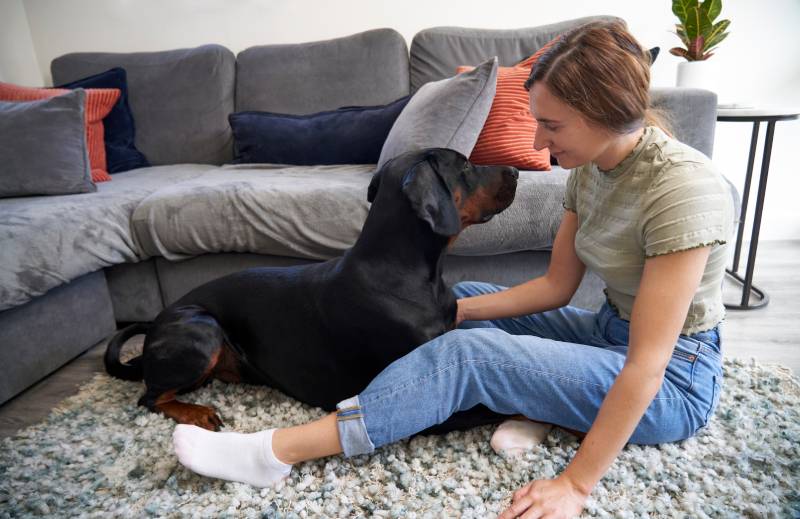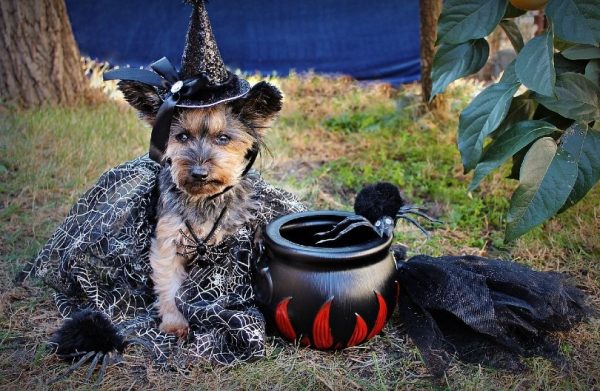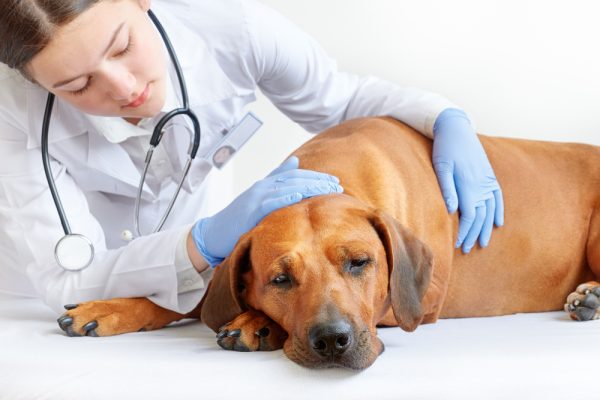In this article
Countless dog owners throughout recorded history have reported that their dogs seemed to sense storms before they occurred, barking or pacing and seemingly trying to alert their owners. Only when bad weather strikes shortly after do owners realize that their dog may have actually seen it coming! Can dogs actually sense tornadoes, storms, and other bad weather ahead of time, though?
In a way, yes, maybe they can. While there is little in the way of scientific studies, it is believed that dogs, as well as cats, have finely tuned senses that can detect minute changes in barometric pressure and electrostatic charges that precede a tornado, hurricane, storm, or any other type of bad weather. We can record these same variations with barometers and other meteorological equipment, but it appears dogs can naturally sense the weather without such things.
If you’ve ever wondered about how to tell when your dog is sensing a tornado or other bad weather, you’re in the right place. Join us below as we shed some more light on signs that your dog is detecting bad weather, how to keep your dog safe, and more frequently asked questions.

How Do Dogs Sense Tornadoes and Other Inclement Weather?
Dogs can sense nearly imperceptible variations in air pressure, like the dramatic plunges that precede tornadoes. Their sense of smell likely plays a role as well, as they may be able to literally smell rain before it arrives at your home. Over time, dogs learn that these signs mean a portentous storm is brewing. Loud noises like thunder and the wind associated with tornadoes can cause your dog intense anxiety and stress even before you know they’re happening, so try to be understanding of their fear.

Signs Your Dog Detects a Tornado
Dogs have a unique way of communicating that relies on body language “tells.” To learn how to tell they’re sensing a tornado or other bad weather approaching, you should watch out for some of the behavior below. It may not guarantee that a tornado is coming, however, since they don’t know the difference between a tornado and just a big storm. Be on the lookout for the below body language cues—a storm could be on its way.
- Restlessness
- Pacing
- Drooling
- Drooping ears
- Panting
- Trembling
- Following you around
- Hiding in a safe place
- Incessant barking, whining, or vocalizing
- Wanting to cuddle

How to Keep Your Dog Safe During a Tornado: Essential Safety Tips

When the worst happens and a tornado is sighted in your area, don’t panic! To be more prepared, refer to our pet storm preparedness tips and consider writing them down for faster future reference. You don’t want to be that person who doesn’t know what to do, so pay close attention!
- Stay up to date with weather forecasts and tornado warnings if you live in a vulnerable area so you have more time to prepare. Don’t forget to turn on your phone notifications if you have a weather app installed on your phone.
- Stay calm to help your dog feel more at ease. If you freak out, your dog will pick up on this and may become anxious in return.
- Keep your dog with you at all times in a harness and leash that they’re comfortable with wearing.
- Never leave your dog behind in case of an emergency.
- If you have a basement or storm shelter in your home, carve out a small space with bedding and your dog’s favorite items so they feel more at ease.
- Consider buying a Thundershirt or dog anxiety jacket that exerts gentle pressure on your dog’s body. This can help make them feel more secure during scary events like tornadoes and storms.
- When your dog is anxious, try redirecting their attention to a game or favored toy to get their mind off things.
- Try to drown out loud thunder and wind with white noise or calm classical music.
- Get your dog microchipped so you can be reunited in case you’re separated during a storm.

Can I Train My Dog to Be Less Afraid of Tornadoes & Storms?
Desensitization training is highly recommended by vets and behavioral experts for helping dogs become less anxious when they sense storms. The foundation is counterconditioning, a technique that teaches your dog to associate negative stimuli (like storms or tornadoes) with a positive mental state.
Start by teaching your dog to “settle” or “relax” in a specific location, like their crate. Introduce your dog’s crate, bed, or mat, then let them check it out and wait for them to use it. When they do, say the “settle” command so that they begin to associate relaxing in the area with your command. If your dog is clicker trained, add a click too. Lastly, shower them with treats and ample praise when they obey. Throw in some white noise or “anti-thunder” music, like classical tunes, while you do this.


Frequently Asked Questions
Do Storm Shelters Allow Dogs and Other Pets?
It depends. FEMA shelters that temporarily house people displaced by storms typically do not allow dogs unless they’re service animals. Shelters run by your municipality, state, or private entities may have different rules, and we’re happy to report that some shelters are pet-friendly!
Search for the shelters nearest you and ask if they’re pet-friendly. If not, they likely know of a shelter that does welcome pets. If you’re unable to take your dog to your preferred storm shelter for any reason, we recommend asking friends, family or veterinarians in unaffected areas if they can temporarily take care of your dog for you. Do not leave them behind!
Are There Any Medications I Can Give My Dog During a Storm?
In extreme cases, your vet may prescribe dog-safe anti-anxiety medications that will help alleviate their distress. In most cases, your vet will recommend desensitization training, though they might prescribe the medication just in case while you work on de-escalating your dog’s fear of storms. Anxiety medications should only be used as prescribed by your dog’s vet to minimize side effects. In the long term, desensitization training is typically more effective at managing storm anxiety.

What Should I Include in a Pet Emergency Kit to Be Prepared for a Tornado?
- 1–2 weeks of your dog’s regular food—cycle out when it expires for a fresh supply at all times
- 1–2 weeks of bottled water (plus water for humans)
- Extra leash and harness/collar
- Collapsible food and water bowls
- Waste bags
- Emergency supply of any medications your dog takes
- Copies of your dog’s medical records/vaccination history in a waterproof plastic bag
- Recent photo of your dog
- Pet first aid kit (with gloves, bandages, gauze, antiseptic, tweezers, scissors, and styptic powder)
- Emergency phone numbers and addresses for your veterinarian or other emergency animal hospital
- Crate/carrier
- Toys
- Blanket

Conclusion
Dogs can seem to tell when storms and tornadoes are coming likely by sensing the barometric air pressure dropping and the electrostatic changes beforehand, smelling the oncoming rain, or hearing the wind. They’ll tell you by pacing, whining, hiding, or cuddling up to your side. Don’t get caught unaware by a tornado. Instead, put together your pet emergency kit and establish a plan for what you’ll do in case a tornado happens near your home.
Featured Image Credit: smrm1977, Shutterstock



















